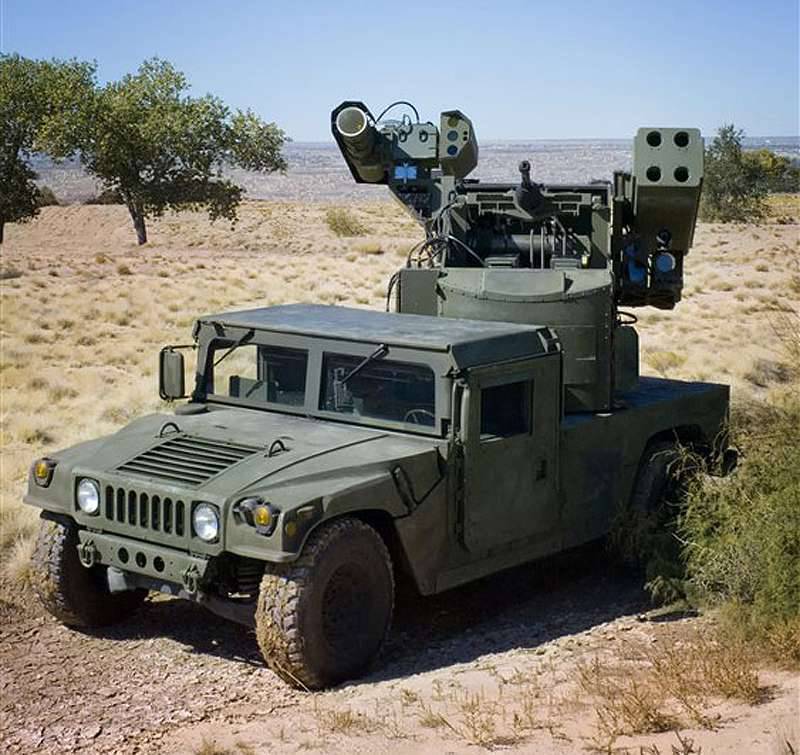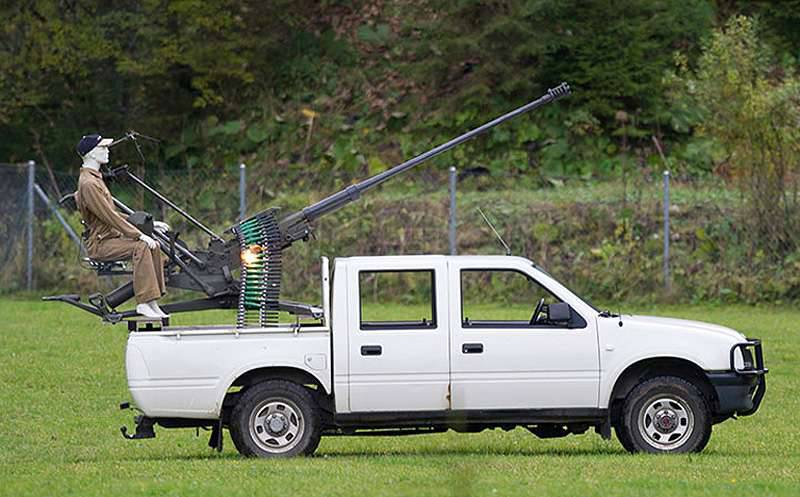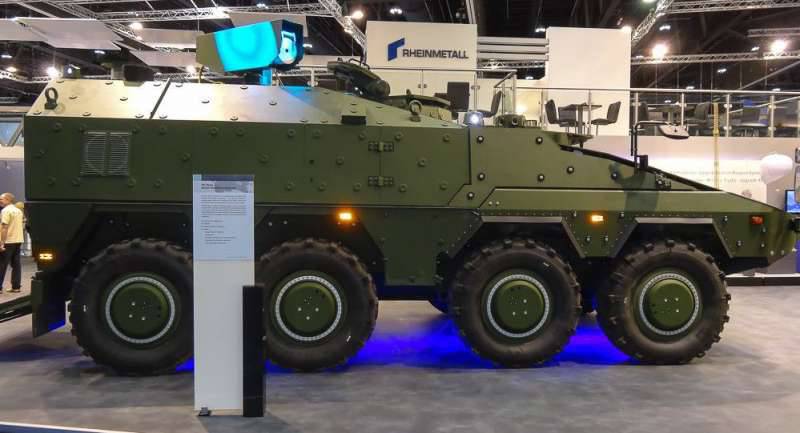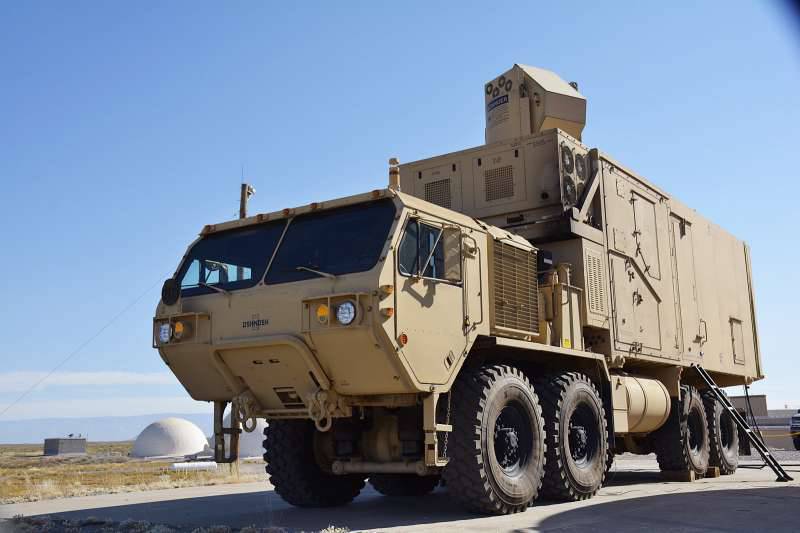Laser quest
The 20 kW laser from Rheinmetall installed on the Boxer 8x8 was presented at DSEI 2015
Technological advances have now reached a milestone when laser-mounted weapons systems have become a reality. Let's look at how these systems enhance combat capabilities.
Vehicle-mounted weapons are an inexpensive tool for enhancing combat capabilities, used by both regular armies and irregular "asymmetrical" formations that participate in almost every conflict in the world.
Until recently, the options for installing weapons on combat vehicles were limited to machine guns and artillery systems of various forms. However, the situation here began to change with the advent of laser systems or systems of directed energy, having sufficient power to burn out small aircraft and ammunition in the air.
Placing bulky blocks of energy storage for such systems has always been a serious problem, but recent developments have helped reduce the size of lasers, allowing them to be installed even on a large jeep.
Technological revolution
In 90's, a technological revolution occurred in fiber-optic communications, which accelerated the development of high-power solid-state lasers, which a decade later found application in industrial processing — branding, cutting, welding and melting.
These lasers were extremely effective over a short distance, but it was a matter of time for the industry to find a way to scale this technology and create a futuristic weaponwhich could cut and melt targets at a distance of several hundred or even thousands of meters.
American defense giant Lockheed Martin did just that. Based on the new production technology of semiconductors, solar cells and automotive welding, the company has developed a laser facility designed for military purposes, which is hundreds of times more powerful than its commercial predecessors.
Robert Afzal, a senior researcher at this company, says: “In this area, a real revolution is taking place today, prepared by many years of gigantic research work. And we believe that laser technology is finally ready in the sense that we are now able to create a laser powerful enough and small enough to be installed on tactical machines. ”
“Previous lasers were just too big - they were entire stations. But with the advent of high-performance fiber laser technology with a high-quality beam, we finally got the last piece of the puzzle in order to install it on such machines. ”
The civilian industry used lasers of the order of several kilowatts, but Afzal remarked that military lasers should be rated at 10-100 kW.
"We developed a technology that allows us to scale the power of fiber lasers, not just building a larger fiber laser, but combining several kilowatt-class modules to achieve the necessary military power."
He said that the laser is based on the addition of rays - a process that combines several laser modules and allows you to form one high-power and high-quality beam that provides efficiency and lethality greater than several individual lasers with 10 kW.
White collimated beam
Describing the process of passing a ray of light through a prism, refracted into many color streams, he explained: “If you have several laser beams, each with a slightly different color, entering this prism exactly at the required angle, they will all come out of this prism with imposition and will form the so-called white collimated beam ".
“Essentially we do this, but instead of a prism, we use another optical element, called a diffraction grating, which performs the same functions. That is, we build modules of high-power lasers, each at a slightly different wavelength, then we combine them, reflecting from the diffraction grating, and at the output we get one high-power laser beam. ”
Afzal said that in fact such a solution is a technology of spectral compaction from the telecommunications sector, combined with high-power fiber-optic lasers from industrial production.
“A fiber laser is the most efficient and powerful laser ever developed,” he said. - That is, we are talking about the total electrical efficiency exceeding 30%, which was not the dream of 10-15 years ago when we had the efficiency of 15-18%. This greatly influenced the power and cooling, so these systems can now become smaller. The laser is now not scaled by building a large laser, but by adding new modules. ”
The US Army recently "recruited" Lockheed Martin to create a high-power laser weapon system based on its ATHENA (Advanced Test High Energy Asset) system, which can be installed on one of the company's lightweight tactical machines.
During last year's tests, a prototype fiber laser with a power of 30 kW successfully disabled a small pickup engine — from a mile in a few seconds, it burned through the grille. In order to simulate the actual operating conditions during the test, the pickup was installed on the platform with the engine running and the gear engaged.
New generation
In October, Lockheed announced that it was launching the production of high-power modular lasers of a new generation, the first of which with a power of 2015 kW would be installed on a tactical machine of the American army.
Afzal said that the army wants to deploy a laser mounted on a vehicle for anti-aircraft tasks, combat missiles, artillery shells and mortar ammunition, as well as UAVs. "We are looking more at the tactical level of defense than on missile defense in a strategic sense."
According to Lockheed, the modular solution allows you to change the power in accordance with the needs of a specific task and the threat. The army has the ability to add more modules and increase power from 60 kW to 120 kW.
Afzal continued: “The architecture is scaled to fit your needs: do you want 30 kW, 50 kW or 100 kW? It is like server modules in a server rack. We believe that this is a flexible architecture - it is better suited for full-scale production. It allows you to get a module that you can re-create over and over again, this allows you to customize the system for you. "
“The system adapts to any vehicle that you want to use at the moment, and this is why this technology is so impressive, because it allows the flexibility of the architecture to be customized for different cars without major modifications to what you decided to have. This allows you to get a system to support both the combat brigade and the forward operational base, for example. "
The system uses commercial fiber lasers assembled into easily reproducible modules, which makes it very affordable. The use of several fiber laser modules also reduces the likelihood of minor faults, as well as the cost and volume of maintenance and repair.
When asked when a battle laser mounted on a tactical machine might appear on the battlefield, Afzal suggested an approximate time frame: “We plan to install our laser at the end of 2016. After that, the army will do its job for some time, and then we will see. "
Laser appeal
There are several characteristics of tactical directed energy weapons that make it very attractive to modern armed forces, including the low cost of “ammunition” and their speed, accuracy and usability.
“First of all, it’s a very accurate weapon with potentially very low collateral damage, which is important,” Afzal added. “The speed of light allows you to instantly irradiate a target, and therefore you can hit highly maneuverable targets, that is, you can keep the beam on a target with which sometimes kinetic ammunition cannot cope.”
Perhaps the most important advantage is the low cost of one effective “shot”.
“At the moment you do not want to expend expensive and powerful defensive kinetic weapons on cheap multiple threats,” continued Afzal. - We consider laser weapons as an addition to kinetic systems. We assume that you will use the laser system against a large number of cheap threats of low intensity, leaving your kinetic shop for attacking you with complex, armored, with a large range of threats. ”
Afzal suggests that laser weapons can be deployed in combat space in the sensor network of operational management, which will provide him with initial target designation.
“First of all, a certain system must report the appearance of a threat, and then the combat control operator decides which countermeasure to use, determines the target, transfers the laser to it and captures the target according to the radar, after which the operator, seeing the target on the monitor, decides does a laser go into action. "
“A lot of problems have accumulated in this area, because the military all over the world already imagined laser weapons themselves a decade ago and the question is why we don’t have them today. I think the main reason is that we did not have the technology to create a laser component of weapons that would be small enough and powerful enough to be placed on tactical machines. ”
Final Stages
Meanwhile, Boeing has also spent several years working on the US Army's High Energy Laser Mobile Demonstrator (HEL MD), which is currently in the final stages of development. A truck-mounted laser fires a high-powered beam at the threats the army is likely to deal with, acting as a system to intercept rockets, artillery shells, mines and UAVs. This system has now achieved such accuracy that it can destroy sensors on drones, which was shown during a 10 kW laser demonstration at White Sands in 2013 and again at Eglin AFB in 2014.
According to the army's technical requirements, the completed HEL MD system will consist of a high-power efficient laser and subsystems adapted for operation in adverse conditions that will be installed on a troop vehicle. The system will be able to carry out, together with other means of destruction, the protection of certain zones, be it advanced bases, naval facilities, air bases and other structures.
Boeing is developing several systems to integrate into the final prototype, which will be installed on a modified heavy terrain truck Heavy Expanded Mobility Tactical Truck (HEMTT).
These subsystems include a laser; beam control; power supply; heat transfer control system and fight control system.
The command of the rocket and space defense of the American army develops HEL MD in stages. The laser, the power supply system and the heat exchange system will be improved over the next few years in order to increase the power and technological sophistication of the subsystems.
As technology advances, the modular nature of the components will allow the introduction of more powerful lasers integrated with improved targeting and tracking capabilities.
Full cycle
According to Boeing, the HEL MD beam guiding device provides coverage of the “whole sky” because it rotates through all 360 °, and it is raised above the roof of the vehicle to capture over-horizon targets. Continuous destruction of targets is simplified by heat exchange and power supply systems.
The whole system runs on diesel; that is, all that is needed to replenish the "ammunition" of a weapon is a quick refueling. Lithium-ion batteries of the HEL MD system are recharged with a diesel generator for 60 kW, therefore, as long as there is fuel in the army, it can function indefinitely.
The system is controlled by the driver of the machine and the operator of the installation using a laptop computer and an Xbox type console. The current demonstration model uses a laser class 10-kW. However, in the near future, the laser will be installed 50 kW class, and in another two years its power will increase to 100 kW.
Boeing had previously developed a smaller laser machine for the American army and installed it on an AN / TWQ-1 Avenger armored car, called the Boeing Laser Avenger. A solid-state laser with a power of 1 kW is used to combat UAVs and neutralize improvised explosive devices (IEDs). The system works like this: it is aimed at an IED or unexploded ordnance on the side of the road with a gradual increase in the power of the laser beam until the explosive is burned out in the process of low-power detonation. During testing in 2009, the Laser Avenger system successfully destroyed 50 for such devices, similar to those found in Iraq and Afghanistan. In addition, there was another demonstration of the system, during which it destroyed several small-sized UAVs.

Laser installation Boeing Laser Avenger
Three year plan
According to the German defense company Rheinmetall, in three years it will offer on the market its own high-power High Energy Laser (HEL) laser mounted on a vehicle.
After a series of tests conducted in Switzerland in 2013, the company worked on expanding the capabilities of the software of the beam forming modules and the technology of the laser itself, after which it predicted that its laser system to combat ground targets as well as for ground defense could be ready in 2018 year.
To work as a mobile platform HEL were selected three cars. Along with the Boxer armored vehicle, its performance was demonstrated by the modified M113 BTR with 1-kW laser (Mobile HEL Effector Track V) and the Tatra 8x8 truck with two 10-kW lasers (Mobile HEL Effector Wheel XX).

All three are three laser-powered platforms.
The 20 kW laser, mounted on a GTK Boxer armored vehicle, is distinguished by an HEL executive module, the advantage of which is its modular construction principle. Rheinmetall says that the Boxer has not yet installed a laser with a power greater than 20 kW, although a combination of several lasers using ray-matching technology could increase its total power. In addition, it is possible to combine several Boxer HEL units, which will create a system with an effective power above 100 kW.
During the demonstration tests conducted in 2013, the Boxer crew confirmed the capabilities of the HEL laser machine, disabling the large-caliber machine gun mounted on the pickup truck without risk to the machine gunner (photo below). In addition, working in tandem with the Skyguard radar, installation on a Tatra Mobile Effector Wheel XX truck demonstrated all stages of the neutralization of a helicopter-type UAV.

Helipad neutralization was performed using SkyGuard radar, which detected and identified the target. Next, the installation of HEL Boxer received data from it, performed coarse and accurate maintenance, and then captured the target for destruction.
Boeing’s HEL MD laser system is being developed under a contract with the United States Missile and Space Defense Command
Marine research
The US Navy Research Administration (ONR) is testing its own vehicle-mounted solid-state combat laser, designated as Ground-Based Air Defense Directed Energy On-the-Move (GBAD OTM). In fact, the system is a high-power laser mounted on a tactical machine, designed to protect the expeditionary forces from the enemy's UAV.
Given the increasingly widespread use of unmanned aviation systems, the US Marine Corps command suggests that combat units will increasingly be forced to defend themselves against opponents conducting surveillance and reconnaissance from the air.
The GBAD OTM system is designed for installation on light tactical vehicles, such as HMMWV and JLTV (Joint Light Tactical Vehicle). According to the ONR Office, the GBAD OTM program is aimed at creating an alternative to traditional systems that can protect infantry from enemy reconnaissance and attack drones. The components of the GBAD OTM system, including a laser, a beam guide, batteries, a radar, a cooling and control system, are being developed jointly by ONR, the Dalgren Center for the development of naval weapons and several industrial enterprises.
The goal of the program is to unite all these components into a single complex, which will be small enough to be installed on light tactical armored vehicles, but powerful enough to combat the intended threats.
Widespread use
As part of the Sea-Air-Space 2015 conference in Washington, the head of the programs for the protection of troops at the ONR Office, Lee Mastroyiani, in a conversation with journalists, explained that lasers can effectively destroy threats across the entire spectrum of air defense, including missiles, artillery shells, mortar ammunition, UAVs, transport means and IEDs. “However, in the first place, the GBAD system is designed to combat small-sized UAVs that pose a threat to our combat units.”
“The GBAD OTM system consists of three main components: a three-coordinate tracking radar station that identifies a threat; the command and control unit, which identifies and decides how to neutralize the threat in the event of the use of missiles or artillery weapons; and the laser platform itself. ”
Mastroyanni noted that in the case of the GBAD program, the emphasis is on developing a high-power laser to destroy a UAV installed on a light combat vehicle.
“There is a substantial argument in favor of such a solution, which is that such threats have a low cost, that is, the use of expensive missiles in this case does not fit into our vision of the problem. Therefore, using a laser that costs a penny a single impulse, you can safely deal with cheap threats with a cheap weapon system. In general, the essence of the program is to fight against similar targets even in motion, in order to support the combat operations of the marines. ”
According to Mastroiani, ONR used several components from the LaWS (Laser Weapon System) demonstration installation, which the US Navy installed on board the Ponce ship in the Persian Gulf.
“We use the principle of predictable avoidance, some of the key technologies and software, but there are also many other problems,” Mastroiani added. - As for the ship USS Ponce, there is plenty of space and everything else, while I have a lot of problems regarding the weight and size and power-consuming characteristics when the system needs to be put on a light tactical vehicle. I have a beam guiding device, power supply, cooling systems, guidance and target designation, and all this should work in concert and without gaps, so the sea of various problems needs to be solved in this particular project. ”
According to the ONR Control, some of the components of the system were used in tests for detecting and tracking drones of various sizes, and the entire system was tested with a 10 kW laser, which is an intermediate solution when switching to a 30 kW laser. It is planned that field tests of the 30 kW power system will take place in the 2016 year, when the program will begin comprehensive tests to move from simple detection and tracking to firing with light troop vehicles.
Materials used:
www.lockheedmartin.com
www.boeing.com
www.rheinmetall.com
www.onr.navy.mil
www.wikipedia.org
en.wikipedia.org


Information